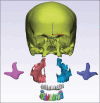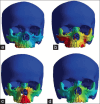Effect of Different Mini Implant Assisted Rapid Palatal Expansion (MARPE) Designs on Maxillary Protraction in Skeletal Class III malocclusion: An FEM Study
- PMID: 38707668
- PMCID: PMC11068238
- DOI: 10.4103/ccd.ccd_428_23
Effect of Different Mini Implant Assisted Rapid Palatal Expansion (MARPE) Designs on Maxillary Protraction in Skeletal Class III malocclusion: An FEM Study
Abstract
Background: Four different designs of mini-implant-assisted rapid palatal expansion (MARPE) and protraction in nasomaxillary complex and mid-palatal sutures in late adolescent skeletal Class III malocclusion were compared using a three-dimensional finite element analysis.
Methods: A finite element model of skull and related sutures was constructed using the computed tomography scan of a 16-year-old female patient with skeletal Class III and ANB of -2°. Four appliance designs: Type I: MARPE with palatal force, Type II: MARPE with buccal force, Type III: Hybrid hyrax with palatal force, and Type IV: Hybrid hyrax with buccal force. Protraction vectors were and analyzed using Ansys software (ANSYS 2021 R2). The displacement pattern of the nasomaxillary structures and the stress distribution in the sutures were examined in all four appliance designs.
Results: All the appliance designs resulted in a forward movement of the maxilla, while Type I and III, which used palatal protraction force, caused the greatest forward displacement. In Type I, II, and III, along with forward movement, a clockwise rotation of maxilla was observed, while in Type IV, an anticlockwise rotation of maxilla was observed. Type I, II, and III resulted in higher stress distribution around the superior structures, while Type IV resulted in less stress distribution around the superior structures of maxilla.
Conclusion: The forward displacement was enhanced when palatal plates were used to protract the maxilla. The effective appliance design for skeletal class III with open bite case was Type I, II, and III and Type IV for deep bite cases.
Keywords: Finite element method; maxillary protraction; mini-implant-assisted rapid palatal expansion; skeletal class III.
Copyright: © 2024 Contemporary Clinical Dentistry.
Conflict of interest statement
There are no conflicts of interest.
Figures








References
-
- Papadopoulou AK, Koletsi D, Masucci C, Giuntini V, Franchi L, Darendeliler MA. A retrospective long-term comparison of early RME-facemask versus late hybrid-hyrax, alt-RAMEC and miniscrew-supported intraoral elastics in growing class III patients. Int Orthod. 2022;20:100603. - PubMed
-
- Gautam P, Valiathan A, Adhikari R. Maxillary protraction with and without maxillary expansion: A finite element analysis of sutural stresses. Am J Orthod Dentofacial Orthop. 2009;136:361–6. - PubMed
-
- Nartallo-Turley PE, Turley PK. Cephalometric effects of combined palatal expansion and facemask therapy on class III malocclusion. Angle Orthod. 1998;68:217–24. - PubMed
-
- Liou EJ. Effective maxillary orthopedic protraction for growing class III patients: A clinical application simulates distraction osteogenesis. Prog Orthod. 2005;6:154–71. - PubMed
-
- Wilmes B, Nienkemper M, Drescher D. Application and effectiveness of a mini-implant- and tooth-borne rapid palatal expansion device: The hybrid hyrax. World J Orthod. 2010;11:323–30. - PubMed
LinkOut - more resources
Full Text Sources
